Hens and chicks will be a great addition to your garden if you want colorful succulents. These plants can change their color from green to red, purple, orange, or blue, making your garden look unique.
The most common reason behind Hens and chicks turning red is temperature stress, and once the temperature gets back to normal, the plant will turn green again. There are other reasons behind Hens and Chicks turning red, like exposure to too much sun and watering issues.
Sometimes, this color change is confusing to understand. Today, we will discuss it to clear your confusion about Hens and Chicks turning red.
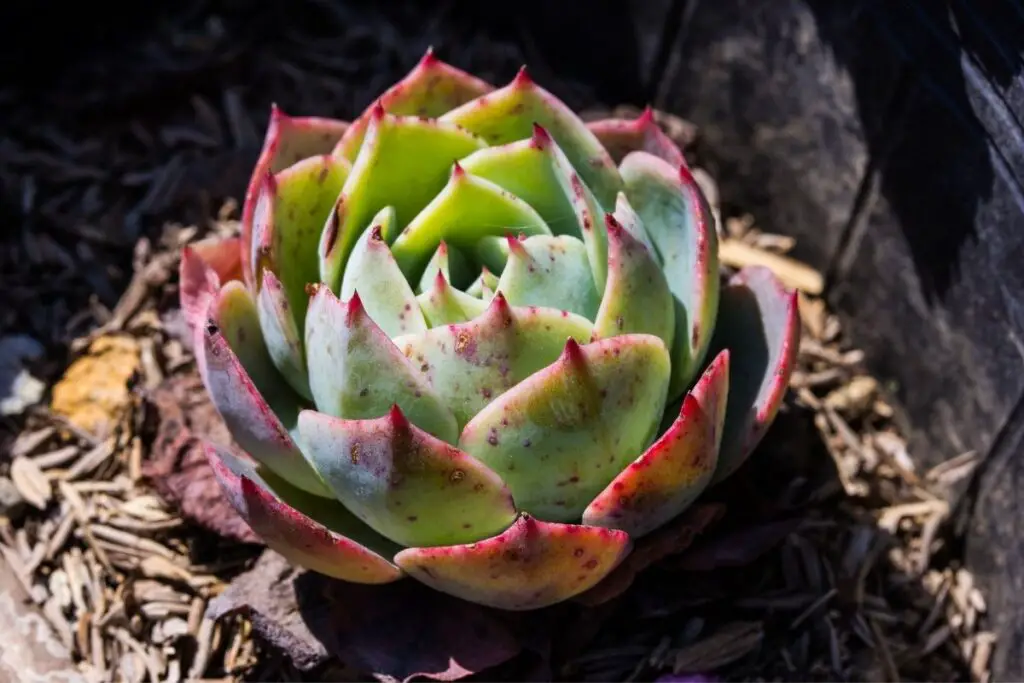
What do red leaves in the Hens and Chicks mean?
When the leaves of your Hens and Chicks start turning red, purple, blue, or orange, it means that they are having some stress.
Mostly it happens because of exposure to extreme temperatures.
Little stress is good for these succulents because it brings out their bright side.
However, you should not just sit back when you see them change their color from green to red.
Check the health of the plant.
The pattern of color will tell you whether the plant is stressed.
Let’s find out the reasons behind Hens and Chicks turning red.
Why do Hens and Chicks turn red under stress?
Generally, when the Hens and Chicks turn red, it implies that they are facing some stress.
It can be either a good one or a bad one.
Very few people are familiar with the cause that makes them change their color from green to red.
Hens and chicks contain two pigments called anthocyanin and carotenoid.
When the temperature or sunlight intensity gets high, the plant produces these pigments and makes the plant red or purple.
The main motive of these pigments is to protect the Hens and Chicks from the harmful UV rays of the sun and extreme temperatures.
It makes sure the plant stays healthy and doesn’t get hurt by such intensities.
Anthocyanin turns them blue or purple, whereas carotenoid turns the plant into red, yellow, or orange.
Whatever the pigment is, the reasons are the same.
What causes the Hens and Chicks to turn red?
Now let’s find out the causes for Hens and Chicks turning red.
Looking for gardening supplies? We have tested 100's of products before recommending them to you guys. Check out our best pick below:
| Image | Gardening Supplies | Best Price? |
|---|---|---|
 Top
Top Top
Top | Raised Garden Bed Kit | Check On Amazon |
 | XLUX Soil Moisture Meter, Plant Water Monitor, Soil Hygrometer Sensor for Gardening, Farming, Indoor and Outdoor Plants, No Batteries Required | No Results |
 Top
Top Top
Top | 82 Pcs Garden Tools Set and Extra Succulent Tools Set | Check On Amazon |
 | Joeys Garden Expandable Garden Hose with 8 Function Hose Nozzle, Lightweight Anti-Kink Flexible Garden Hoses, Extra Strength Fabric with Double Latex Core, (50 FT, Black) | No Results |
 Top
Top Top
Top | Dual Chamber Compost Tumbler | Check On Amazon |
 Top
Top Top
Top | Sunnyglade Plant Stakes | Check On Amazon |
 Top
Top Top
Top | Organic Cold Pressed Neem Seed Oil | Check On Amazon |
 Top
Top Top
Top | Mighty Mint Gallon :-Insect and Pest Control Peppermint Oil | Check On Amazon |
 Top
Top Top
Top | Scotts DiseaseEx Lawn Fungicide | Check On Amazon |
 Top
Top Top
Top | Jacks Classic 20-20-20 All Purpose Fertilizer | Check On Amazon |
 Top
Top Top
Top | 30,000 Seeds Pollinator Attracting Wildflower Mixture | Check On Amazon |
 Top
Top Top
Top | Survival Vegetable Seeds Garden Kit-Over 16,000 Seeds | Check On Amazon |
Temperature change
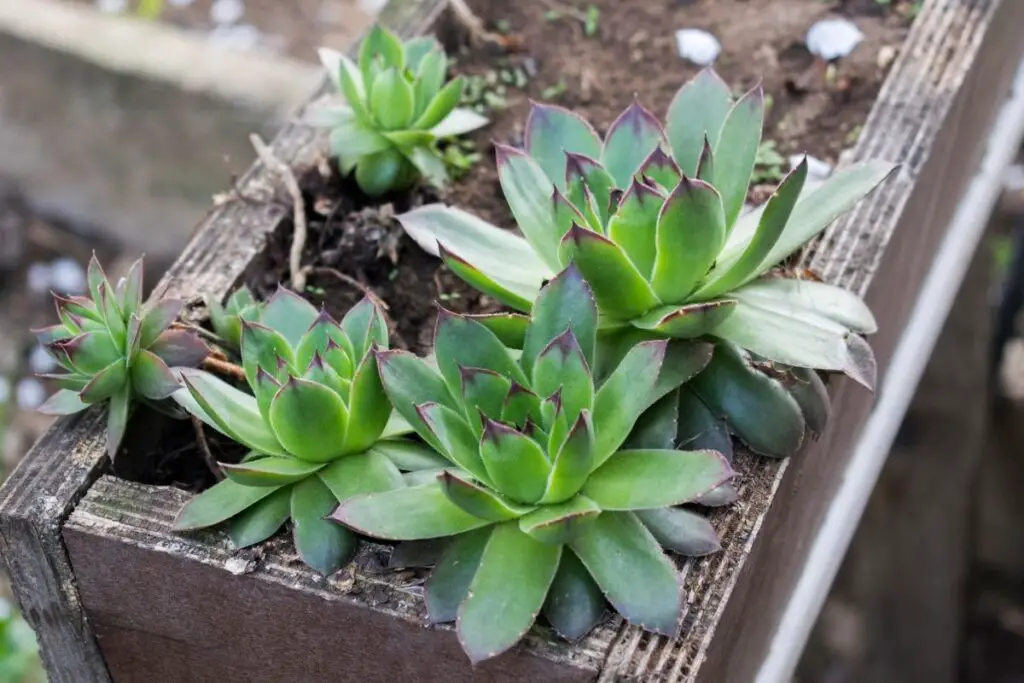
You will see your Hens and Chicks will turn red naturally at two times of the year:
- At the end of winter
- At the beginning of early spring
These two times are the moments when there is a change in temperature from cold to warm.
It can be because they have been getting cold and suddenly now they are getting warm temperatures.
This temperature change will initiate the pigments for protection and turn the plant red.
The whole process is natural, and you don’t have to worry about it.
It is a good emphasis. The color patterns differ in varieties.
For example, in Ruby Heart, at first, the red color is seen at the tips of the leaves.
Gradually, it will start spreading down the leaves.
In other varieties, the red color is visible in the middle of the foliage.
It will slowly begin to spread.
When the color stops spreading further, the location of the color is exact in all.
Also read: Can You Leave Hens And Chicks Outside In Winter?
Exposure to extreme temperatures
The Hens and Chicks will turn red when the temperature is too hot or too cold.
When the temperature gets too high or too low, the pigments in the plant get activated and make the plant turn red.
It is natural, and there is nothing to do with it.
These pigments will protect the foliage from getting hurt due to such extreme hot or cold temperature conditions.
Receiving such temperatures mimics the pressure that Hens and Chicks generally face in their natural habitat.
So, there is no harm here.
Let the plants have this stress because it is suitable for their health, and it allows them to disclose the color out of them.
Also read: Hens And Chicks Temperature Tolerance: (How Cold, How Hot?)
Exposure to sunlight
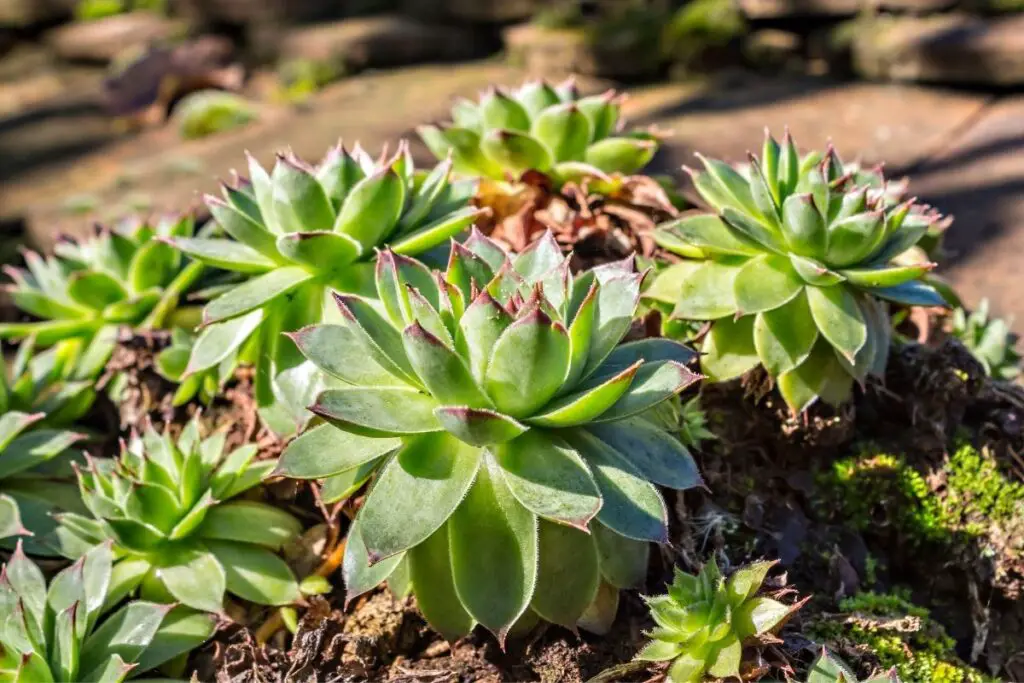
Another reason why Hens and Chicks turn red is receiving too much sunlight.
This stress can be either good or bad.
More or less, all the Hens and Chicks will require direct sunlight.
The dwarf varieties need 4-6 hours of direct morning sunlight.
They also need protection from the punishing sun of daytime and afternoon.
The larger varieties need full sun for 8-12 hours without any protection.
If the sunlight is too harsh with high temperatures (90°F or above), the plant will produce the pigments to protect itself from the harmful sun rays and high temperatures.
It is a good thing.
Though the plants protect themselves through these pigments, you still need to protect them by shading if the heat is too intense.
If the signs first turn red and then brown, your Hens and Chicks are probably getting sunburn.
Also read: How Much Sun Do Hen And Chicks Need? (Light Requirement)
Less watering
It is not a watering problem. So, no treatment is required.
If you water your Hens and Chicks daily, they will maintain their luscious green color.
It will also prevent them from suffering drought conditions.
Hens and Chicks are drought-tolerant plants.
They can store water in their broad leaves, stems, and roots.
When you keep the plant thirsty for some time, the plant will begin storing water in its leaves.
Due to this, the leaves become fatty, juicy and they even manage to blush, i.e., turn red.
Again, it is not bad.
Because they can hold moisture; so, they won’t die.
But don’t make this thirsty period lengthy. To bring out the plant’s red color, restrict a bit on watering.
Also read: How Much Water Do Hens And Chicks Need? (Underwatering+Overwatering)
Pest infestation
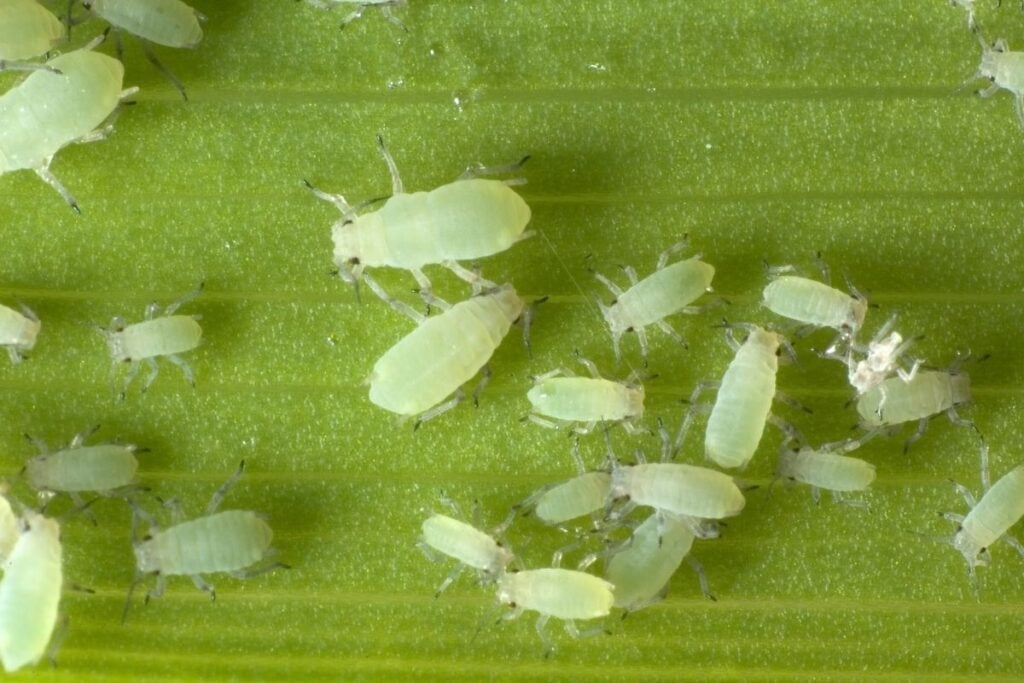
Hens and Chicks are very hardy succulents and resistant to all kinds of pests or fungal infestations.
With little care and attention, you can quickly get your plant rid of bugs.
When you find that the leaves and stems have reddish tints, it is a sign of infestation by spider mites.
They leave behind red spots in the leaves.
If you observe the plant closely, you will notice some black moving spots and fine web lines.
These are indications of mites staying and feeding on the leaves.
Whenever you see red marks in your plant, inspect the plant closely to confirm the problem. It is distress.
You need to remove them as soon as possible.
How to fix pest infestation?
- Dab a cotton ball damped with rubbing alcohol on the infected area.
- Spray some neem oil.
- But make sure not to expose the plant to direct sunlight after applying the oil.
- It can burn the leaves.
- Let the plant remain under partial shade until all the pests get removed.
- After that, you can keep them under direct sunlight.
- Use insecticidal soaps like Safer Soap to remove the mites.
In severe cases, the above methods will fail.
Then you have to apply chemical insecticides and pesticides.
Don’t let your plant remain overwatered or underwatered for too long.
Spider mites attack the most during long dry conditions.
How do I differentiate good stress and bad stress?
By now, you must have known that Hens and Chicks turn red due to stress.
But do you know whether they are good or bad for the plant? Let’s talk about it.
In their natural habitat, Hens and Chicks go through a lot of stress, especially extreme temperatures, temperature changes, and exposure to too much sun.
These factors are natural and not artificial.
When they receive the same stress in your garden, it makes them realize that they are in their native land.
So, when Hens and Chicks are getting such stress, it is good for their health.
It helps them maintain their original shape and texture. It also encourages it to bring out its color.
Now, how to identify whether it is good or bad?
In good stress, the plant will look completely fine.
Only their color will change.
When distressed, the plant will show other signs other than red, like stretchy, mushy or weak.
You have to identify the problem and fix it.
When the plant turns red due to extreme temperature or sunlight, it suggests that they are trying to adjust to the heat by producing carotenoids to protect themselves.
But, if you find red tints on the leaves and stems along with bite marks, they are probably due to spider mites.
Prolonged dry conditions are responsible for it.
So, it is artificial and harmful stress.
In this way, you have to identify the real problems behind the color change and treat them fast before it increases.
Why do some gardeners stress their plants?
Some people deliberately stress their Hens and Chicks.
It might be a bad idea to listen to, but it can improve the health of your plant.
However, it is up to you whether you want to do it or not.
Giving stress will let the Hens and Chicks think they are growing in their natural habitat.
It will encourage them to grow well and display their actual color, shape, and texture.
A pampered plant will not show its colorful characteristics or reach its potential.
So let them have the stress.
Don’t feel bad about stressing your plant.
Hens and Chicks are quite hardy succulents that will endure any pressure with ease.
But make sure to treat the redness due to pest infestation.
It is terrible and needs quick treatment.
How to stress the Hens and Chicks to turn them red?
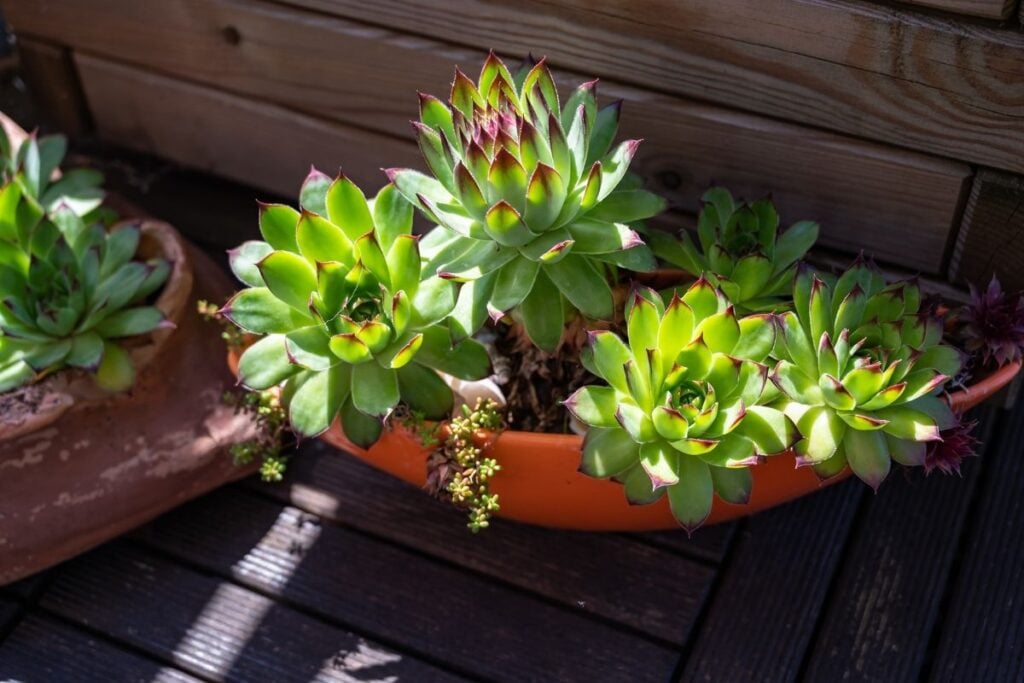
Stressing the Hens and Chicks on purpose helps bring out their actual appearance.
But give them good stress, not a bad one.
While giving the plant good stress, avoid the bad stress like:
- Prolonged overwatering or underwatering. It can invite pests like spider mites.
- Prolonged exposure to harsh sunlight, leading to sunburn.
Now let’s get to the good stress part.
Below I have shared a few tips to stress the Hens and Chicks to help them show reddish hues:
Let the plants have enough sunlight.
If you have kept them under shade, open them.
The more sunlight they get more they will develop red hues.
At least 6-8 hours of direct sunlight is needed.
Many people transplant Hens and Chicks in pots and bring them inside to protect them from extreme temperatures.
Let them remain outside instead.
Temperatures below -40°F or higher than 90°F gives them extremely low or hot temperature stress.
You will see the Hens and Chicks turning red during the hottest summer months or the coldest winter months.
However, some protection is needed if the sun and heat are too harsh because it can result in sunburns.
Using the right soil mix will help the succulents to change their color.
The plant will be weak if the soil holds moisture for long.
But if the soil is draining water well, then dry soil can help the plants turn red.
Use equal parts of garden soil and sand, perlite or gravel. Avoid peat.
Water rarely. If you keep them thirsty, Hens and Chicks will store more water in the leaves, thus making the foliage broader, juicier, and reddish.
The more water they store, the redder they will look.
Final thoughts: Is Hens and chicks turning red good or bad?
Red is good only if the stress is natural and doesn’t wither the plant’s health.
Temperature change, extreme temperatures, exposure to the sun, and strict watering are good stresses.
Out of these, exposure to sunlight and spare watering should not be for extended periods. It can otherwise make the plant weak.
Don’t hesitate to give your plant stress. It is better for them.
It makes them feel they are in their native land and encourages them to highlight their colorful appearance.
Hens and Chicks having progressed red marks on the leaves and stems is not good.
You need to identify the problem quickly and immediately start treatment.
Reference: Wikipedia, Iowa State University of Science and Technology, The University of Arkansas Division of Agriculture, NSDU, The Ohio State University, Missouri Botanical Garden.
